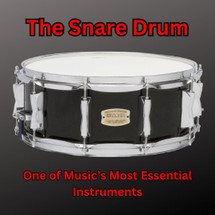Posted by Steve Head on 18th Aug 2024
The Snare Drum: A Deep Dive into One of Music’s Most Essential Instruments
As the owner of Kopf Percussion, I’ve spent a lot of time thinking about the various elements that make up the world of percussion. One of the most iconic and versatile instruments in this realm is the snare drum. Whether you’re a seasoned drummer or just starting out, understanding the snare drum is crucial to mastering the art of percussion. In this blog post, I’ll discuss what I have learned of the history, construction, and unique sound of the snare drum. We’ll also explore how it compares to other percussion instruments like the cajon.
The History of the Snare Drum
The snare drum has a long and storied history, with roots that date back centuries. Originally, drums with snares were used in military settings to communicate signals and keep marching soldiers in step. Over time, the snare drum evolved from a simple field drum into the more refined version we see in orchestras, marching bands, and drum kits today.
Historically, the snare drum was often made from wood with a natural skin drumhead, and the snares themselves were made from gut. These early snare drums were much larger than the modern versions, with deep shells and a lower pitch. Over the centuries, as musical styles evolved and the demand for different sounds grew, the snare drum adapted, becoming smaller, tighter, and more versatile.
The Construction of a Snare Drum
Understanding the construction of a snare drum is key to appreciating its unique sound. A typical snare drum consists of a cylindrical shell, drumheads on the top and bottom, and a set of snares stretched across the bottom head. The shell is usually made of wood, metal, or a combination of materials, and the drumheads are typically made of synthetic materials like Mylar.
- The Shell: The material and thickness of the shell significantly impact the sound of the snare drum. Wood shells, like those made from maple or birch, produce a warm, resonant tone, while metal shells, such as brass or steel, offer a brighter, crisper sound.
- The Drumheads: The top drumhead, or batter head, is where the drummer strikes the drum, while the bottom head, or snare head, is thinner and more sensitive to vibrations. The tuning of these heads can drastically alter the drum’s sound, allowing for a wide range of tonal possibilities.
- The Snares: The snares themselves are usually made of coiled metal wires, although some drummers prefer synthetic materials or gut for a more vintage sound. These snares vibrate against the bottom head when the drum is struck, creating the characteristic “snap” or “crack” that defines the snare drum’s sound.
The Unique Sound of the Snare Drum
The snare drum is known for its sharp, staccato sound, which is produced by the snares vibrating against the bottom head. This sound is what gives the snare drum its distinct voice, making it an essential part of any drum kit or percussion ensemble.
One of the reasons the snare drum is so versatile is its ability to produce a wide range of sounds depending on how it’s played. By adjusting the tension of the drumheads and snares, drummers can achieve everything from a tight, crisp “crack” to a loose, resonant “buzz.” The playing technique also plays a significant role; rimshots, ghost notes, and rolls can all add different textures to the snare drum’s sound.
For those who appreciate the versatility of percussion instruments, it’s worth exploring the cajon, another instrument with a wide range of sounds. While the cajon lacks the sharpness of a snare drum, it offers its own unique tonal palette, making it a valuable addition to any percussionist’s setup.
The Role of the Snare Drum in Music
The snare drum’s sharp, cutting sound makes it a key element in many musical genres. In rock and pop music, the snare drum often serves as the backbeat, providing the rhythmic foundation that drives the song. In jazz, the snare drum is used for intricate, syncopated rhythms, often played with brushes for a softer sound. In marching bands and military music, the snare drum’s precision and clarity are essential for keeping time and adding dynamic accents.
The snare drum’s versatility extends beyond these genres, finding a place in everything from classical music to hip-hop. Its ability to produce a wide range of sounds—from a soft, subtle buzz to a loud, aggressive crack—makes it an indispensable tool for drummers and percussionists alike.
Choosing the Right Snare Drum
When it comes to choosing a snare drum, there are many factors to consider. The size, material, and construction of the drum all play a role in determining its sound and feel. For example, a smaller snare drum (e.g., 13” x 4”) will produce a higher pitch and shorter sustain, making it ideal for funk or pop music, while a larger snare drum (e.g., 14” x 8”) will offer a deeper tone and longer sustain, which might be better suited for rock or orchestral music.
For more in-depth information on snare drums, including detailed reviews and comparisons, this video provides a wealth of knowledge from experts in the field.
Conclusion: The Snare Drum in Your Percussion Setup
The snare drum is more than just a part of a drum kit—it’s a versatile, essential instrument that can add depth and character to any musical performance. Whether you’re a seasoned drummer or just starting, understanding the nuances of the snare drum will help you make informed choices about your gear and playing technique.
At Kopf Percussion, I’m passionate about all things percussion, and I’m always here to help you find the right instruments for your musical journey. Whether you’re looking to add a snare drum to your collection or exploring other percussion instruments like the cajon, there’s a world of rhythm waiting for you. Explore my collection of handcrafted cajons and discover the perfect addition to your setup.


